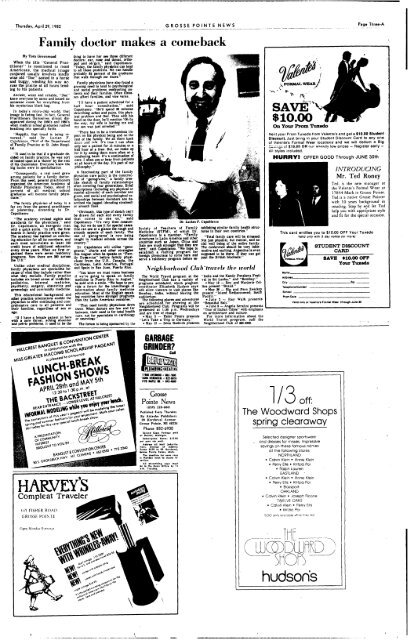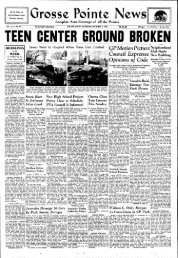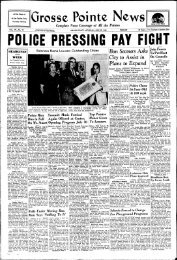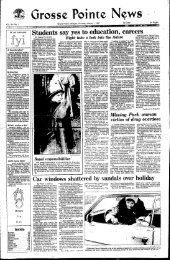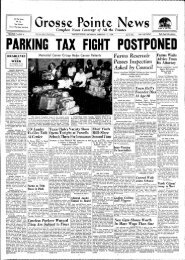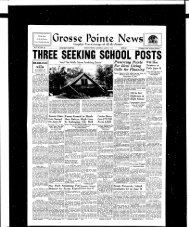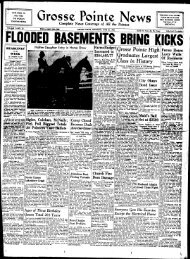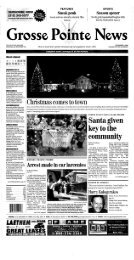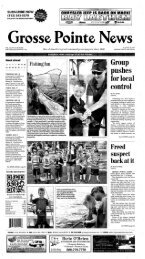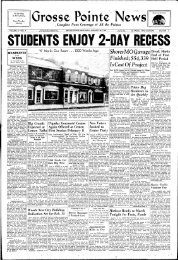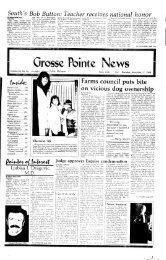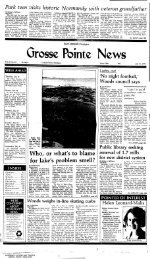You also want an ePaper? Increase the reach of your titles
YUMPU automatically turns print PDFs into web optimized ePapers that Google loves.
Thursday I April 29 I 1982 ___ ~._~_?_~_~_EP O__ '_N_T_E__N_E_W_~ ._._. . ..__. _0<br />
By Tom Greenwood<br />
Family doctor makes a comeback<br />
When the title "General Practitioner"<br />
is mentioned to most<br />
Americans, the medical image<br />
conjured usually involves kindly<br />
wise old "Doc" seated in a horse<br />
and buggy, winding his way across<br />
the prairie at all hours tend.<br />
ing to his patients.<br />
Ancient, wizen and reliable, "Doc"<br />
knew everyone by name and issued no .<br />
nonsense cures tor everything from<br />
his mysterious black bag.<br />
In today's micro-chip world, that<br />
image is fading fast. In fact, General<br />
Practitioners themselves almost disappeared<br />
during the 1950's and 1960's<br />
when medical school graduates rushed<br />
headlong lnto specialty fields.<br />
"Happily, that trend IS being reo<br />
versed," said Dr. Lucian F.<br />
C~~b!!!nN). ('l\j"f of {hI' ~p.artment<br />
of Family Practice at St. John Hospl.<br />
tal.<br />
"It used to be that if a graduate decided<br />
on famlJy practice, he was sort<br />
01 looked upon as a 'dunce' by the rest<br />
01 his classmates. Everyone knew the<br />
big bucks were in specialiUltion.<br />
"Consequently, a real need grew<br />
among patients for a family doctor.<br />
From lhls need, general practltioners<br />
organiJ.ed the American Academy 01<br />
Family Physicians. Today, about 15<br />
percent of all medical school<br />
graduates will become family physicians."<br />
The family physician of toda~ is a<br />
far cry from the general pracUtioner<br />
of yesterday, B ccordlng to Dr.<br />
Capobianco.<br />
"The academy revlaed sIght5 and<br />
.tandards for the physicians," said<br />
Dr. Capobianco, an energetic man<br />
with a quick smile. "In 1971, the first<br />
board. in famlly practice were given,<br />
The academy ha. 1llIIlted on continuo<br />
ing education for all ita members, and<br />
each mu.t accumulate at lealt 160<br />
credit hour. of addltlonal education<br />
every three years. When we t1~ or.<br />
,anlled lhere were seven residency<br />
Pl'OITamJ. Now there are 390 acrou<br />
the U.S."<br />
Unlike other medical disclpllnes,<br />
'amily pbyJ1cIBlU are specialists because<br />
of what they include rather than<br />
what they exclude. Family practice<br />
lncludea six broad areas of med1clne:<br />
pedJatrics, Internal medicine,<br />
psychiatry, sUT,ery, obstetrics and<br />
gynecology and community medicine.<br />
This educational background and<br />
other practice orientations enable the<br />
physician to olfer continuing and com.<br />
prehenaive care to all patienu and<br />
their families, regardless of sex or<br />
age.<br />
"U 1 have a female patient in here<br />
with a lOre throat. Ichtng shoulder<br />
and pelvic problems, It UIed to be 1M<br />
HARVEY'S<br />
Compleat Traveler<br />
~1j5 FISHER RO/\[)<br />
GROSSE POJ:- ..:T,E:<br />
thing to have her see three different<br />
doctors: ear, nOie and throat, ortho-<br />
~d and ob/gyn," said Capobianco.<br />
'Today, the family phyJ6clan can tend<br />
to all these problems. We can handle<br />
probably 85 percent of the problems<br />
that walk through our dool'l,"<br />
Family physicians have also found a<br />
growing need to tend to psychological<br />
and socia) problems confronting patients<br />
and their families. otten illnesses<br />
aIled famlties, and vice versa.<br />
"I'U have a patient scheduled for a<br />
half hour consultation," said<br />
Capobianco. "He'll spend 29 minutes<br />
describing aches and pains, this physical<br />
problem and that. Then with his<br />
hand on the doo~l he'll mention 'Qb by<br />
the way, my WIle is leaving me and<br />
my son was jusl arrested.' "<br />
"There has to be a tremendous impacl<br />
on his physical being and on the<br />
rest of the family. We sit them back<br />
..lnoo,~ .. ..A tAIll: h'lI true I can often<br />
~~iy-'~-~patient for 15 minutes or a<br />
halt hour at a time. But, we make up<br />
for it by seeJ.ng them more often on a<br />
continuing basIs. It's a continuation 01<br />
care. I often Se4! or hear from patients<br />
at aU hours of the day. It's part of our<br />
philosoph y ."<br />
A fascinating part of the family<br />
physician care polley is the construction<br />
of "genograms," a family treelike<br />
skelch of family relationships<br />
often coveri~ four generations. Briel<br />
descriptions (includJng any physical or<br />
mental ailments) of each member are<br />
given, and social and psychological relationships<br />
between members are described<br />
via jagged (denoting strained)<br />
or smooth Unes.<br />
"ObvI0U51y. this type of sketch can't<br />
be drawn for each and every family<br />
that comes to .ee us," laid<br />
Capobianco. "It'. very time cODlumloa,<br />
but we do UJe It for .peclaJ caJeI,<br />
One can lee at a glance the rough and<br />
.mooth 81pectl of each family. The<br />
use of ',enogram.' I. now being<br />
taught in medical .choolJ acl'Oll the<br />
COWltry."<br />
Dr. Capobianco will u.tillze ",enograms,"<br />
charta and other strategiel<br />
this Augu.lt when be .pew on "Fam.<br />
lIy ny.mica" before family phy.l.<br />
clan. from the V,5., Canada, the<br />
Caribbean, Latin America, Portugal<br />
and Spain in San Juan, Puerto Rico.<br />
"You know we must mean bualnesa<br />
IC we're going to speak on famllr,<br />
mediclne In Puerto Rico in August, '<br />
he said ,,1th a smile. "We hope to provi


